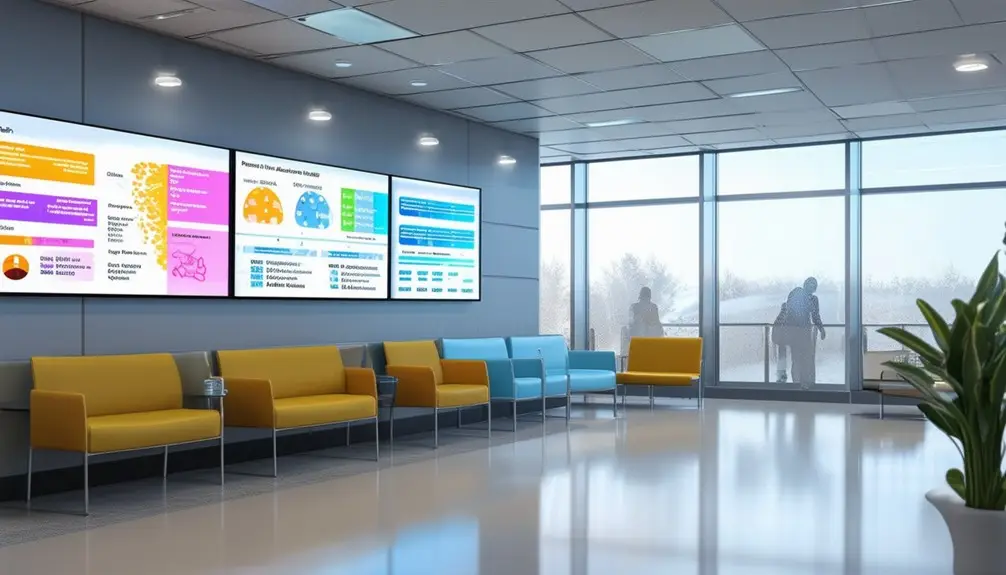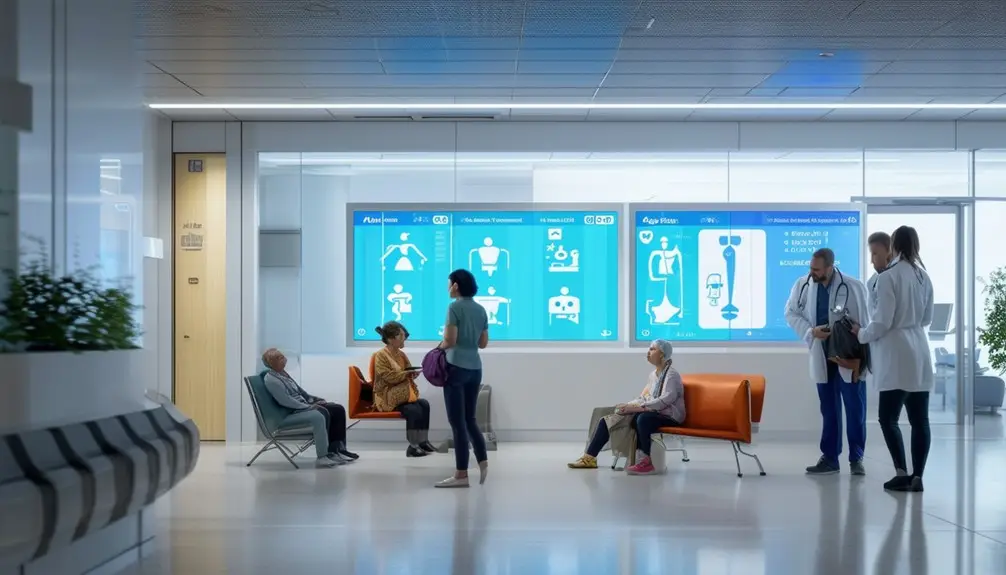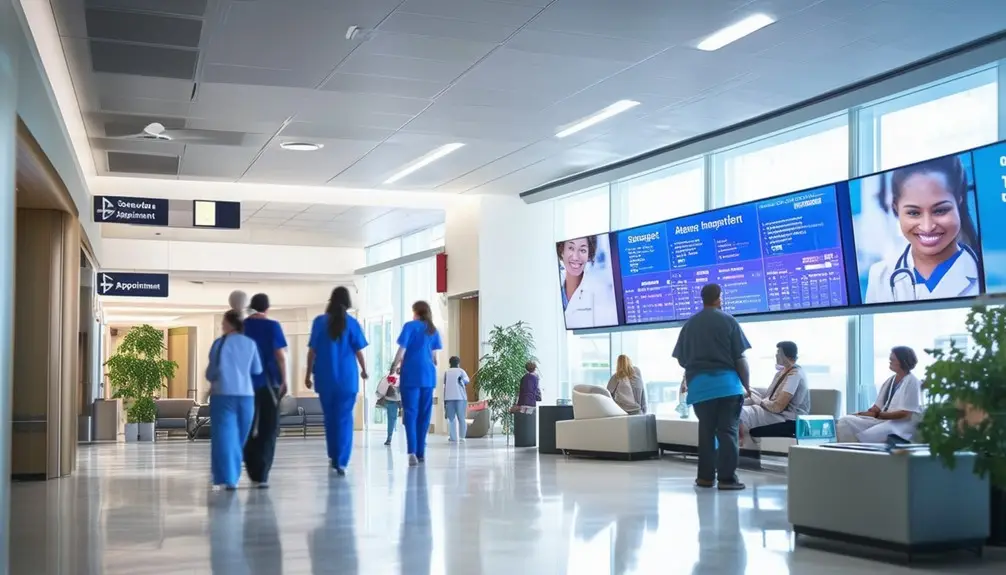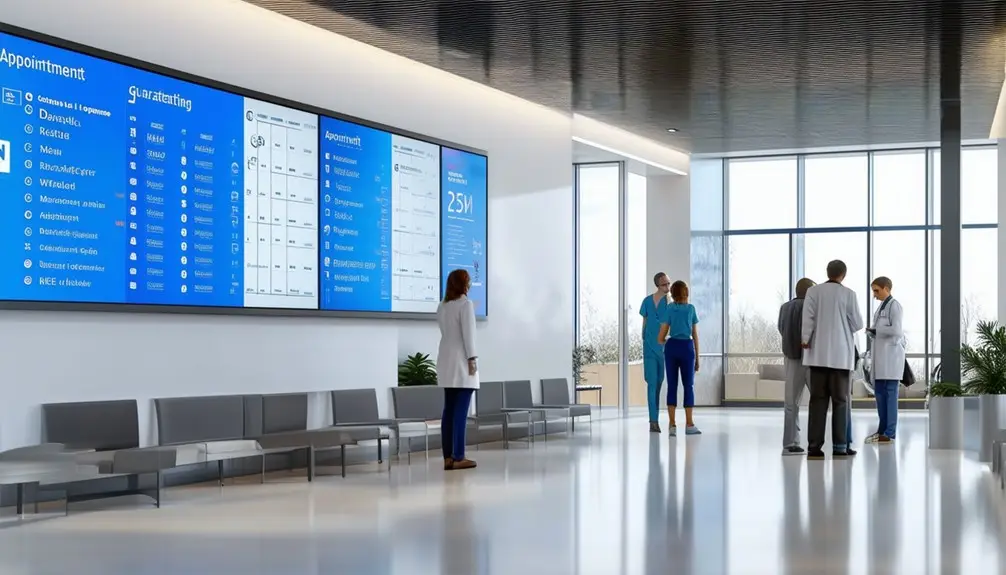Real-time digital displays in hospitals can transform your experience. They streamline scheduling with self-service check-in kiosks and queue management systems, reducing wait times. These displays provide clear navigation through interactive maps and signage, ensuring you reach your destination efficiently. You’ll also benefit from enhanced communication with real-time updates, keeping you informed and minimizing delays. Patient education improves with interactive displays offering personalized health tips and videos. Hospitals can promote their services and collect immediate feedback through these systems, driving continuous improvements. Discover the detailed advantages and technical benefits awaiting implementation in modern healthcare settings.
Table of Contents
ToggleKey Takeaways
- Digital kiosks offer self-service check-in and appointment confirmation for improved efficiency.
- Real-time updates on digital displays help reduce patient wait times and improve flow.
- Interactive maps on screens assist patients and visitors in navigating the hospital.
- Queue management systems prioritize patient flow, ensuring timely medical attention.
- Live feedback collection through displays aids in continuous service improvement.
Wayfinding and Navigation

Real-time digital displays in hospitals streamline wayfinding and navigation by providing interactive maps and multilingual support, guaranteeing patients and visitors can easily locate their destinations. These interactive digital signage systems utilize real-time updates, allowing you to navigate hospital environments efficiently. By integrating visual landmarks into the maps, these systems offer clear directions, reducing the chances of navigation interruptions.
The deployment of digital kiosks at strategic locations throughout the hospital significantly improves hospital navigation. These kiosks provide users with precise, real-time information, effectively reducing confusion and aiding you in finding your way. The multilingual support feature ensures that non-English speaking visitors can navigate the hospital without difficulty.
Wayfinding signage that incorporates real-time digital displays contributes to efficient wayfinding by offering continuous updates on route changes, facility closures, or room relocations. This proactive approach minimizes disruptions and guarantees a smooth flow of foot traffic, saving hospitals considerable costs annually by reducing the need for manual interventions.
Incorporating these advanced wayfinding technologies not only enhances the patient experience but also streamlines hospital operations. Clear maps, visual landmarks, and real-time updates collectively facilitate better hospital navigation, making your visit less stressful and more efficient.
Patient Education

Leveraging interactive digital displays for patient education can greatly enhance your engagement and understanding of medical information, increasing patient participation by up to 80%. These displays can provide real-time appointment updates, ensuring you never miss critical consultations. By integrating health education videos, you gain a clearer understanding of complex medical procedures, reducing anxiety and improving compliance.
Interactive digital screens also deliver personalized health tips and preventive care information tailored to your specific needs. This targeted approach not only augments your patient knowledge but also fosters healthy behaviors, leading to better long-term health outcomes. For example, if you have diabetes, you might receive specific dietary recommendations and exercise routines directly on the screen.
Live health workshops can be broadcast via these digital displays, offering you the opportunity to engage in real-time learning sessions. These workshops cover various health topics, from nutrition to chronic disease management, enhancing your overall grasp of essential health concepts.
In essence, utilizing digital displays for patient education transforms how you receive and process health information, making it accessible, personalized, and engaging. This approach ultimately empowers you to take a more active role in your healthcare journey.
Effective Communication

By utilizing digital displays, hospitals can greatly enhance effective communication, thereby reducing patient wait times and improving overall satisfaction. Digital signage provides real-time updates on appointment information, guaranteeing patients are promptly informed about any changes. This leads to a more efficient flow of communication, minimizing confusion and reducing appointment delays.
Healthcare digital signage solutions improve operational efficiency by allowing hospital staff to manage schedules and appointments seamlessly. Instant updates on appointment statuses enable staff to address any issues, preventing bottlenecks and streamlining processes quickly. This efficient communication system directly impacts patient satisfaction, as patients are less likely to experience long wait times and more likely to feel informed and cared for.
The use of digital signage enhances the overall patient experience. Real-time updates keep patients aware of their appointment status, reducing anxiety and improving their perception of the hospital’s efficiency. Clear, concise communication through digital displays helps patients know exactly where they need to be and when, providing a smoother, more organized experience.
Incorporating digital signage into hospital operations not only aids in managing appointment information but also significantly enhances communication, operational efficiency, and patient satisfaction. This modern approach to information dissemination guarantees that both patients and staff benefit from streamlined processes.
Streamlined Scheduling
You can streamline scheduling by utilizing self-service check-in kiosks, which allow patients to confirm their appointments and update their information autonomously. Real-time appointment updates displayed digitally guarantee both patients and staff are aware of any changes immediately, reducing confusion and wait times. Additionally, queue management systems optimize patient flow by providing accurate wait times and directing patients efficiently to their next location.
Self-Service Check-In Kiosks
Self-service check-in kiosks, through their advanced scheduling capabilities, can greatly diminish patient wait times by up to 75%, enhancing overall efficiency in hospital reception areas. These digital solutions streamline scheduling, offering a more organized and timely check-in process. By incorporating real-time appointment updates, patients can easily confirm their appointments and receive immediate feedback, further reducing delays.
Digital signage on these kiosks provides clear, user-friendly instructions, notably improving the patient experience. This clarity ensures that patients can navigate the check-in process with minimal assistance, which in turn eases the staff workload. The use of digital check-in boards also supports efficient patient flow, reducing registration time by 50%.
The streamlined scheduling facilitated by self-service check-in kiosks leads to a 30% increase in patient satisfaction. The real-time information and efficient processing prevent bottlenecks and minimize the time patients spend in waiting areas. As a result, hospitals can manage larger patient volumes without compromising service quality. To sum up, self-service check-in kiosks not only enhance check-in efficiency but also contribute to a more positive patient experience and a more manageable workload for hospital staff.
Real-Time Appointment Updates
Building on the efficiency of self-service check-in kiosks, real-time appointment updates through digital displays provide up-to-the-minute scheduling information, significantly reducing patient wait times and enhancing overall satisfaction. These interactive screens allow patients to instantly check for any appointment changes or delays, making sure you’re always informed. This seamless access to real-time appointment updates means you spend less time waiting and more time receiving care.
Digital displays streamline scheduling by offering instant updates on appointment availability and changes, improving communication between staff and patients. This guarantees that any alterations in the schedule are immediately reflected, helping to reduce bottlenecks and improve the flow of patients through the hospital. By providing real-time information, these systems not only enhance patient satisfaction but also optimize the efficiency of hospital operations.
Interactive screens also play an essential role in facilitating timely communication between healthcare providers and patients. Whether it’s an unexpected delay or an available earlier slot, you’re kept in the loop. This transparency helps build trust and keeps you engaged with your care process. Overall, real-time digital displays are a data-driven solution that directly addresses the need for more efficient and patient-centered healthcare services.
Queue Management Systems
Queue Management Systems (QMS) significantly enhance hospital efficiency by providing real-time updates and prioritizing patient flow, ultimately reducing wait times by up to 30%. QMS streamlines scheduling through digital displays, offering immediate insights into appointment status and patient wait times. This data-driven approach not only boosts operational efficiency but also notably improves the overall patient experience.
Incorporating QMS into your hospital’s workflow offers several key benefits:
- Real-time updates: Patients and staff receive instant notifications about appointment status, reducing uncertainty and stress.
- Appointment reminders: Automated reminders via text or email ensure that patients are well-informed and less likely to miss their appointments.
- Prioritized patient flow: By managing the sequence of appointments efficiently, QMS help prioritize urgent cases, ensuring timely medical attention.
Streamlined scheduling through QMS also enables better resource allocation, ensuring that medical staff can focus on patient care rather than administrative tasks. This results in a more organized and responsive healthcare environment. The notifications and updates provided by QMS minimize patient frustration, contributing to a higher satisfaction rate.
Promoting Hospital Services

Real-time digital displays effectively promote hospital services by showcasing a wide array of amenities, medical programs, and ongoing events. These displays function as a dynamic platform to increase awareness of the hospital’s capabilities. By highlighting support services and ongoing campaigns, you can ensure that patients and visitors are well-informed about what the hospital offers.
Integrating appointment updates and Queue Management Systems into these displays greatly enhances the patient experience by reducing wait times and improving overall efficiency. For example, patients can see real-time updates on their appointment status, allowing them to manage their time better. Additionally, Queue Management Systems streamline patient flow, minimizing congestion and confusion.
These digital displays can also be tailored to target specific audiences, ensuring that the right information is communicated effectively. For instance, they can advertise health screenings and preventive care tips, thereby raising awareness about important health issues within the community. By promoting various medical programs and events, hospitals can engage patients more actively and encourage participation in health-related activities. Overall, utilizing real-time digital displays strategically can transform the way hospital services are marketed and consumed, leading to an improved patient experience and enhanced operational efficiency.
Staff Training and Development
Digital displays offer an advanced solution for enhancing staff training and development by delivering up-to-the-minute updates on educational content and protocols. By leveraging digital signage, you can guarantee that your healthcare team accesses the latest training schedules and updates, leading to improved knowledge retention and communication efficiency.
- Up-to-the-Minute Updates: Digital displays provide immediate updates on hospital protocols and educational content, allowing staff to stay informed without delay.
- Interactive Training Resources: Incorporating interactive training resources such as videos and quizzes on digital displays can engage your staff more effectively, making learning both dynamic and thorough.
- Tailored Content Delivery: Customizing the content displayed to match the specific needs of different departments enhances communication efficiency and ensures that relevant information reaches the appropriate personnel.
Implementing digital displays for staff training streamlines the entire process, enhancing operational efficiency and ultimately leading to better patient care outcomes. By providing up-to-the-minute updates and interactive training resources, you can boost staff engagement and development, ensuring that your team is well-prepared to handle evolving hospital protocols. This approach not only supports improved knowledge retention but also fosters a culture of continuous learning and professional growth within your organization.
Collecting Patient Feedback

By utilizing real-time digital displays, you can prompt patients to provide immediate feedback through surveys, testimonials, and interactive touchscreens. Analyzing this response data allows you to identify trends and areas for improvement, ensuring a data-driven approach to enhancing patient care. Implementing these suggestions effectively will not only address current issues but also foster increased patient satisfaction and loyalty.
Survey Methods Overview
Surveys provide a structured and data-driven approach to collecting patient feedback on hospital appointments, utilizing methods such as email, online forms, and in-person interviews. By leveraging these surveys, you can gather valuable insights into your scheduling processes and enhance patient satisfaction with your appointment scheduling systems.
There are several effective channels for conducting surveys:
- Email: Sending surveys via email allows you to reach a broad audience quickly and efficiently. It’s highly scalable and convenient for patients to respond at their leisure.
- Online Forms: Online forms are user-friendly and can be integrated into your hospital’s website or patient portal. They provide a seamless way for patients to give feedback immediately after their appointments.
- In-Person Interviews: Conducting in-person interviews offers a more personalized touch and can yield deeper insights. This method, though more time-consuming, allows for real-time clarification and follow-up questions.
Each of these channels helps you collect patient feedback that can be analyzed to pinpoint trends and areas for improvement. By systematically collecting and acting on this feedback, you can continually refine your appointment scheduling systems, ultimately leading to higher patient satisfaction and more efficient hospital operations.
Analyzing Response Data
Once you’ve gathered patient feedback through various survey channels, the next step involves meticulously analyzing the response data to uncover actionable insights for improving your hospital appointment systems. Begin by employing real-time data analysis to identify patient feedback trends. These trends will highlight common issues and preferences related to appointment scheduling processes, enabling you to tailor your strategies effectively.
By examining satisfaction levels, you can pinpoint areas needing immediate attention, such as excessive wait times or subpar staff interactions. Addressing these pain points through data-driven strategies will not only optimize patient experience but also enhance overall efficiency.
Dive deep into the feedback concerning communication enhancements. Patients often provide valuable insights on how to streamline operations and improve the clarity of your communication channels. By refining these aspects, you enhance patient satisfaction and foster better interactions between staff and patients.
Additionally, analyze response data to evaluate the effectiveness of current appointment scheduling processes. This evaluation helps you implement adjustments that improve scheduling accuracy and reduce patient wait times. Ultimately, utilizing patient feedback trends to make informed decisions will contribute significantly to streamlining operations and boosting the overall efficacy of your hospital appointment systems.
Implementing Suggestions Effectively
Incorporating patient feedback effectively hinges on leveraging live digital screens to gather actionable data on appointment scheduling experiences. By utilizing these digital displays, you can directly capture patient feedback on their appointment scheduling and wait times, which provides invaluable live data. To guarantee continuous improvement and notably enhance patient satisfaction, you need a structured approach to feedback collection mechanisms.
- Live Surveys: Implement brief, user-friendly surveys on digital screens in waiting areas. These can capture immediate impressions of the appointment scheduling process.
- Feedback Kiosks: Set up dedicated kiosks for patients to provide detailed feedback on various aspects of their experience, from scheduling to the actual appointment.
- Interactive Displays: Use interactive digital screens that allow patients to rate their satisfaction and suggest improvements right after their appointment.
These methods facilitate a steady stream of live data, empowering you to make data-driven decisions. Analyzing this data helps you identify patterns and areas needing optimization. Implementing the gathered insights can notably enhance the appointment experience, ensuring that scheduling processes are continually refined. This feedback loop not only boosts patient satisfaction but also leads to a more efficient and responsive appointment scheduling system.
Conclusion
Implementing real-time digital displays for hospital appointments will streamline operations and enhance patient experiences. You’ll navigate with ease, access vital information instantly, and communicate effectively. These displays aren’t just screens—they’re your gateway to a smoother, more informed visit. By integrating this technology, we’re not just updating systems; we’re upgrading lives. You’ll find scheduling seamless, staff well-trained, and services promoted efficiently. Collecting patient feedback will become a breeze, ensuring continuous improvement in care delivery.
Frequently Asked Questions
What Is the Digital Signage Software for Hospitals?
Digital signage software for hospitals provides real-time updates on appointment schedules, streamlines check-ins, and reduces wait times. It integrates seamlessly with systems, enabling customizable content like reminders and notifications, thereby enhancing overall efficiency and patient experience.
What Are the Advantages of Using LED Displays for Wayfinding Signage?
Imagine never getting lost again! LED displays for wayfinding signage offer unmatched visibility, real-time updates, and energy efficiency. They’re customizable, durable, and cost-effective, making them perfect for guiding patients and visitors in complex hospital environments.




